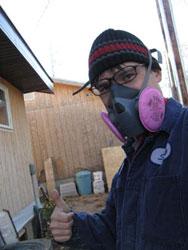Bois Forte Indoor Air Quality Program
Midwest EPA Region 5 Tribal Champion

Kevin Koski, Environmental Health Specialist, Bois Forte Reservation Tribal Government
Before joining the Bois Forte Band of Chippewa Environmental Services team, Kevin earned an architectural degree in Environmental Design and applied his knowledge and skills to environmental testing and hazardous materials remediation. Kevin is a strong believer in the importance of IAQ management to improve the health and quality of life for community members, and aims to share his knowledge and skills with as many other communities and community members as he can so that they can enjoy the highest quality of life.
“For a variety of reasons, modern building science and IAQ issues have the power to affect people’s health and well-being more than ever before. At Bois Forte, we are working hard to gain all of the expertise we can, work with as many partners as we can, and design as many projects as we can to improve the health of Bois Forte band members." - Kevin Koski
Program Summary
What began as a serious incident when, in 2000, several residents of the Bois Forte Reservation were revealed to have chronic health problems indicative of mold exposure, has grown into one of the most successful and expansive tribal indoor air quality (IAQ) programs in the country. After the revelation, Bois Forte conducted an investigation and based on the results, implemented a remediation project that dramatically improved the families’ health. The ordeal opened the eyes of Bois Forte Environmental Services to the need for a plan to combat and prevent the effects of mold and moisture in tribal homes on the reservation. The Bois Forte IAQ Program was set in motion. Since its inception, this program has had many accomplishments, acquired a wide array of IAQ testing and inspection equipment, obtained technical expertise, and achieved investigative capabilities. All of this hard work led to outstanding results in the health of families on their reservation, and also led to the Bois Forte IAQ program receiving a “Center of Excellence” distinction from EPA.
Key Strategies
Bring All Stakeholders to the Table: Developing effective partnerships on the regional and national level is one secret to the Bois Forte IAQ Program’s success. The IAQ program works directly with their housing department, attending meetings and home inspections, trading advice and strategies, and co-directing remediation projects. Another close partnership is with local contractors, whom IAQ program administrators work with to review plans for new construction and hold them accountable for the quality of their work when the construction is complete. The program’s partnership with the Bois Forte Health Services has opened up opportunities to host training sessions, partner on intervention projects, and sponsor asthma awareness functions. On a national level, the Bois Forte IAQ Program works with the American Lung Association (ALA), the U.S. Department of Housing and Urban Development (HUD), Communities Reducing the Environmental Triggers of Asthma (CRETA), and the Minnesota Department of Health (MDH). Tackling IAQ issues in tribal regions is not an easy job. By recognizing that help from existing organizations can make that job easier and more impactful, both regionally and at the national level, the Bois Forte IAQ program is able to take advantage of each partner’s strengths to create a blend of professionals who comprehensively tackle IAQ issues from all angles.
Build on Success: Bois Forte wanted to do more than just find IAQ issues; they wanted to find a way to prevent the issues from ever occurring. To do this, they expanded their services to include preventative diagnostics to find problems before they led to mold growth and other IAQ issues that could impact health. Other Bois Forte IAQ Program expansions have stemmed from requests and interests that come up as the program’s reputation spreads. Because of a request, Bois Forte expanded their program to include Tribal casinos for the testing of Environmental Tobacco Smoke (ETS). Also, due to an interest in the use of infrared thermography to diagnose IAQ problems, Bois Forte has worked to help tribes purchase infrared cameras and provide them training. By keeping their program open to new and different requests for change and expansion, the Bois Forte Indoor Air Program is never stagnant and continues to reach a variety of communities.
Empower Others to Lead: Bois Forte holds regional training sessions to give other tribes’ health and housing departments and construction team’s strategies to effectively manage existing IAQ issues before they manifest into health problems and prevent them from occurring in the future. This mentorship provides participating tribes the opportunity to develop the skills and knowledge they need to become strong leaders in the development of indoor air programs.
